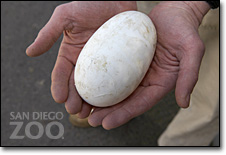 |
|||||
Great Spotted Kiwi |
|||||
 |
|||||
|
Reproduction |
||||
|
|
How
do Great
Spotted Kiwis reproduce?
Great Spotted Kiwis mate for life. Couples have been known to last twenty or more years. They live in pairs in the burrows or dens. The main breeding season is between June and March, because that is when the food is most plentiful for the Great Spotted Kiwi. When held in captivity, the male kiwi reaches sexual maturity at 18 months and females lay their first eggs at around 3 years old. When in the wild, however, Kiwis do not reach sexual maturity until much later in life. The first eggs are usually laid between 3 and 5 years of age. The male does not have any bright colors or beautiful songs to attract the female. Instead, he uses the strategy of persistence. He follows her around and grunts until she notices him. If she is not interested, she either runs away or uses her greater weight and size to ward him off. If she is interested, they mate for life. During peak activity, they mate 2-3 times each night. So how do they actually go about the process? The male strokes the female on her back near the base of her neck. She crouches down, stretches out her neck, and rests it on the ground. The male then climbs onto the females back and balances, which can be quite difficult without wings and a tail. During the act, the female calls all the shots. If she gets bored or uninterested, she will flip off of her back and walk away, leaving the male embarased and undignified to find a different mate. Although divorces are rare, they do happen on occasion. The pair mate for about 3 weeks before the egg is laid. The female Great Spotted Kiwi lays just 1 egg in a single breeding season. Kiwi eggs have one of the largest egg to body size ratio of all birds. Most birds have about 35-40% yolk in their eggs, but the Great Spotted Kiwi has about 65%. This means that the kiwi's eggs have far better nourishment than most bird eggs. The egg is usually about 20-25% of her body mass, so when the egg is produced, there is little room left in her body for much else. Because of this, the female fasts for a few days, and then lays the egg. After the egg is laid, incubation is left up to the male. He incubates the egg for 75-85 days, only leaving for a few hours during the night to hunt. During that time, the female takes over. It takes the chick 2-3 days to simply crack out of the egg. All Kiwis are precocial, which means that they leave the egg looking like a smaller version of the adult. Unlike all other Kiwi species, the chick stays in the burrow or den for about a year after hatching. The chick is defenseless for the first 17-20 weeks of its life. During this time, most are killed by stoats, dogs, and weasles. It takes about 6 years for the Kiwi to reach its full size. |
|
|
||
| Questions or comments? Contact me at reiland.lian@students.uwlax.edu | |||||
| Last updated April 25th, 2008 | |||||
